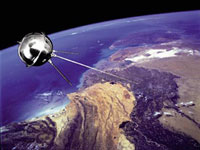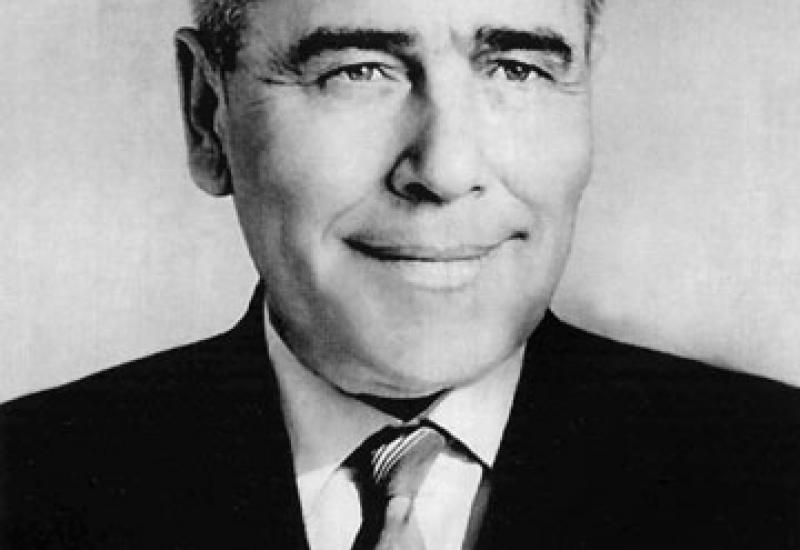Michael Yangel was born October 25, 1911 in the village Zyryanova Nyzhnoilimskyy district of Irkutsk region in a large family. His parents - Kuzma Lavrentiyovych and Anna Pavlovna - had 12 children. Michael was the sixth child.
Parents themselves illiterate, wanted to give the children education. In his native village, Michael graduated from primary school (three classes). The school was located in an ordinary farmhouse. A teacher lived in one room, while scholars of all three classes occupied second room. Then Michael lived with his grandmother in Nyzhnyeilimsk, where he finished fourth and fifth grades. In the autumn of 1924 13-year-old Michael instead of school went with his father two hundred miles from his village in the taiga to hunt fur-bearing animals. The returned only in February. Next academic year he was studying in Kuytun, where he lived with his aunt. In the summer of 1926 he went to Moscow to his elder brother Constantine - student Mining Academy. Michael was studying in the seventh grade, and after school working as a paperboy. To save money, given him for the tram, he walked, and as he proudly recalled later, he knew Moscow lengthwise and crosswise. After seventh grade, Michael moved in. Krasnoarmiis'k Moscow region, where he studied for two years at the factory school in the weaving factory. Graduating the school, he worked for two years as the factory assistant master. The factory produced cloth-sheathing aircraft - percale, often it was visited by pilots and Michael began to dream about aviation.

In 1931 on the ticket of the Komsomol M.K.Yanhel was sent to study at the Moscow Aviation Institute (MAI). Studying in the last year, he began working in the DB of Nikolay Polikarpov - "King of Fighters" of the time. Under the guidance of Polikarpov he completed thesis project entitled "High-altitude fighter with an airtight cabin." Later M.K.Yanhel wrote: "I studied Engineering at MAI, but genuine school of engineering and collective creativity I passed in the design office of M.M.Polikarpov."
In 1938 for familiarization with the general level of American technology and experience of American firms, M.K.Yanhel for seven months was on a business trip in the US. After the trip, he was appointed assistant chief designer. DB developed new fighter I-180, which should surpass the newest fighters in all parameters: speed, maneuverability and armament.
In December 1938, M.K.Yanhelya was slandered. It was claimed that he - the son of a kulak, who hides in the forest. M.M.Polikarpov provided M.K.Yanhel vacation, and he went five thousand kilometers in his native village to get the documents that have to refute this slander. The trip was very difficult. Suffice to say that it was December, and he had to cross on a boat the river Angara width of one kilometer with a very strong current.
During World War II M.K.Yanhel worked as the foreman of the aircraft factory. It was very tense. Sometimes, some days he was not leaving the workshop.
In 1944 M.K.Yanhel worked as deputy chief engineer in the RDB A.I.Mikoyan, in 1945 - leading engineer in DB V.M.Myasischev, in the 1946-1948 - in the office of the Ministry of Aviation Industry where coordinated development of aircraft.
In 1950, M.K.Yanhel graduated from the Academy of Aviation Industry of the USSR, and was appointed head of the department in DB Sergei Korolev. He was involved in the development of R-5, R-7, R-11. In 1952 M.K.Yanhel was appointed director of SRI-88, which included DB Sergei Korolev, and later - his chief engineer.
In 1954 M.K.Yanhel was appointed head and chief designer of the Special Design Bureau 586 in Dnipropetrovsk. In the newly launched DB it was started the development of missile engines on fuels with components that have a high boiling point, and autonomous control system.
June 22, 1957 at the Kapustin Yar polygon it was successfully launched strategic missile R-12 with a range of up to 2000 km. In 1959 this rocket have adopted. P-12 was an effective means of national defense during the Cold War. Based on these missiles Strategic Rocket Forces (SRF) were created. Their the first commander was marshal M.I.Nedyelin. The missile R-12 was the deciding factor of nuclear deterrence during the Caribbean crisis. By the way, the first stage of the missile R-12 (propulsion system with combustion chambers) is exhibited at the State Polytechnic Museum at NTUU "KPI".
 In 1960-1963 they were developed and adopted for the service missiles complexes with missiles R-14 and R-16.
In 1960-1963 they were developed and adopted for the service missiles complexes with missiles R-14 and R-16.
Due to efforts M.K.Yanhel it was created a powerful missile cooperation of organizations developers and manufacturers of many industries USSR.
In the period from 1963 to 1968 under the leadership of M.K. Yangel they were developed strategic complexes R-36 (8K67, 8K69). The complexes were equipped with liquid rockets that guarantee keeping them fueled and ready to launch for seven and a half years. Orbital main part that was launched on the low space orbit, could approach to a target from any direction, making it impossible for defense forces to intercept it. This is what made the US for talks on nuclear arms reduction, and that this is the greatest merit of M.K. Yangel.
Since the early 60s the company MK Yangel transformed from a purely missile to missile and space. In 1962 rocket 63C1 ("Cosmos") orbited artificial satellite DS-1 (Dnepropetrovsk Sputnik) - "Cosmos-1". Later the carrier "Cosmos" brought into orbit, Soviet, French, Indian satellites. A cabin for landing an astronaut on the Moon and return to the orbital ship was created in Dnepropetrovsk on the order of DB Sergei Korolev.
M.K.Yanhel launched missile systems work on the third generation MR-UR100 (15A15), MR-UR100 UTTH (15A16) R-36 (15A14) - the famous "Satan," which included by US to be the first for destruction when signing the agreement on disarmament .
In subsequent years, DB "Yuznnoe" building on the first chief designer M.K.Yanhel ensured the creation and launch of missiles of fourth generation R-36M2 complex with heavy rocket "Voivod" 15ZH60 stationary and rail 15ZH61. They are now a top perfection of the modern world rocketry. Created on the basis of operational missiles space carriers "Cosmos", "Intercosmos", "Cyclone-2", "Cyclone-3", "Zenit» obtained widely international importance.
 Successful M.K.Yanhelya activity was determined by his high creative potential. He was a man of high moral and professional qualities. He was distinguished by his ability to think big, to see clearly perspective.
Successful M.K.Yanhelya activity was determined by his high creative potential. He was a man of high moral and professional qualities. He was distinguished by his ability to think big, to see clearly perspective.
Activities M.K.Yanhel were highly appreciated by the country. He was twice Hero of Socialist Labor (1959, 1961), winner of the Lenin (1960) and the State (1967) awards, academician of Academy of Sciences of the Ukrainian SSR (1961), Academy of Sciences of the USSR (1966 ), PhD (1960). Schools and streets in Kiev, Dnepropetrovsk, Moscow were named after him. His name was given to a peak in the Pamirs, a crater on the moon, DB "Yuznoe".

